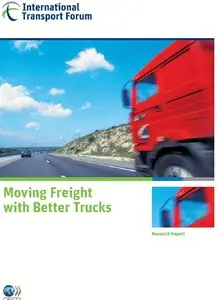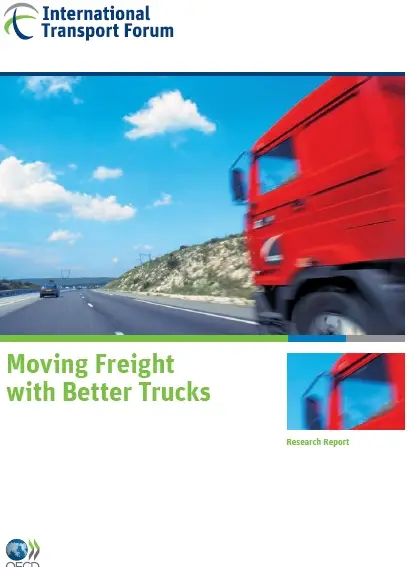Moving Freight with Better Trucks: Improving Safety, Productivity and Sustainability
OECD / ITF | 19 Apr 2011 | ISBN: 9282102930 | 361 pages | PDF | 4 MB
OECD / ITF | 19 Apr 2011 | ISBN: 9282102930 | 361 pages | PDF | 4 MB
The purpose of this report is to identify potential improvements in terms of more effective safety and environmental regulation for trucks, backed by better systems of enforcement, and to identify opportunities for greater efficiency and higher productivity.
MegaUp Download • | • ES Download
The report is based on a review of literature, consultation among stakeholders, and research and analysis from working group members. It also presents the results of a comprehensive benchmarking study of 39 truck configurations in operation around the world – from typical workhorse vehicles to very high capacity vehicles – and assesses their performance in terms of dynamic stability, productivity and impact on the infrastructure.
Table of Contents
FOREWORD
KEY MESSAGES AND CONCLUSIONS
Context
Key Messages
Conclusions
CHAPTER 1. TRENDS IN ROAD FREIGHT TRANSPORT
1.1. The role of road freight transport
1.2. Perspectives and issues for this report
1.3. Features of the history of trucking
1.4. Public perception and amenity
1.5. Trends in road freight policies
1.6. Evolution of freight transport in OECD and ITF countries
1.7. Road freight costs
1.8. Road pricing for trucks
CHAPTER 2. LOGISTIC CHALLENGES IN THE ROAD TRANSPORT
2.1. Loading capacity – Massing out
2.2. Transport as an element in logistics decision making
2.3. Transport decision making
2.4. Logistics drivers and trends
2.5. Organisational structure of the road freight transport sector
2.6. Development of costs, prices and margins
2.7. The availability of skilled drivers
2.8. The efficiency of road freight transport
2.9. Challenges in the market for road freight transport services
2.10. Public interventions in logistics processes
2.11. Conclusions
CHAPTER 3. REGULATION OF ROAD FREIGHT TRANSPORT
3.1. The regulatory framework
3.2. Technical vehicle standards
3.3. Weights and dimensions
3.4. Trends in heavy vehicle technical standards
3.5. Environmental standards
3.6. Truck operations
3.7. Drivers
3.8. Transport operators
CHAPTER 4. EVALUATION OF TRUCK PERFORMANCE
4.1. Benchmarking concept
4.2. Vehicle benchmarking method
4.3. Vehicles
4.4. Performance measures
4.5. Results
4.6. Influences on performance measures
4.7. Results summary
4.8. Productivity and efficiency benchmarking
4.9. Calculating power and energy
4.10. Impacts of trucks on pavements and bridges
4.11. Conclusions
CHAPTER 5. ENVIRONMENTAL CHALLENGES
5.1. Local air pollutants
5.2. Fuel consumption and CO2 emissions
5.3. Noise emissions
5.4. Conclusions
CHAPTER 6. HEAVY TRUCK SAFETY
6.1. Introduction
6.2. Recent trends in fatal truck crashes
6.3. Truck crash patterns
6.4. Accident causation factors
6.5. Measures to improve the safety of trucks
6.6. Vehicle technology - Driver support and communication systems
6.7. Conclusions
CHAPTER 7. INFRASTRUCTURE CHALLENGES
7.1. Introduction
7.2. The effect of truck traffic on pavements
7.3. The effects of trucks on bridges
7.4. Safety barriers, piers, bridge supports and expansion joints
7.5. Impacts on road traffic
7.6. Tunnels
7.7. Intermodal terminals
7.8. Conclusions
CHAPTER 8. CURRENT USE OF HIGHER CAPACITY VEHICLES
8.1. Introduction
8.2. Status regarding the operation of Higher Capacity Vehicles in OECD/ITF countries
8.3. Assessment of impacts of Higher Capacity Vehicles: overview and conclusions of main studies
8.4. Conclusions
CHAPTER 9. REGULATING FOR IMPROVED PERFORMANCE
9.1. Types of regulation
9.2. Performance-based regulation for trucking
9.3. Industry partnerships: Canada – Saskatchewan
9.4. Weights and dimensions review: Canada – interprovincial
9.5 Safe, Productive and Infrastructure-Friendly (SPIF) vehicles: Canada – Ontario
9.6 Performance Based Standards (PBS) Scheme: Australia
9.7. Performance Based Standards demonstration projects: South Africa
9.8. Geographical and jurisdictional considerations
9.9. Conclusions
10. COMPLIANCE AND RESPONSIBILITY
10.1. Introduction
10.2. Approaches to compliance and enforcement
10.3. Enforcement and compliance technologies
10.4. Sanctions and penalties
10.5. Measuring and monitoring
10.6. Achieving compliance in trucking
10.7. Conclusion: new approaches - compliance as an enabler
ANNEX A. VEHICLE TECHNICAL STANDARDS: UNECE AGREEMENTS
1958 Agreement
1998 Agreement
Outlook
ANNEX B. TRUCK SAFETY DATA (COMPLEMENT TO CHAPTER 6)
B.2. Comparisons of fatality rates
ANNEX C. EVOLUTION IN FREIGHT TRANSPORT
BIBLIOGRAPHY
TECHNICAL GLOSSARY
LIST OF ACRONYMS
ACKNOWLEDGEMENTS AND LIST OF PARTICIPANTS
with TOC BookMarkLinks
More : You find here



